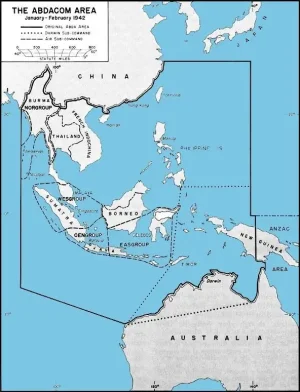- Military History
- Alliances, Treaties, Pacts & Commands
- ABDA Command - 1941
ABDA Command - 1941
The British Chiefs of Staff convinced Churchill to accept a unified command in the Southwest Pacific
On December 28, 1941, British and American leaders agreed to create a unified command for Allied forces in the Far East. After formal assent of the other governments involved, General Sir Archibald P. Wavell (Commander-in-Chief for India) became head of ABDACOM (American, British, Dutch and Australian Command).
His responsibilities included command of all forces in Burma, Malaya, the Dutch East Indies and the Philippines, but his orders prevented him from exercising that authority.
He could not relieve subordinate commanders (each of whom represented a different national interest) and he could not interfere with the organization of national forces under his command. Rather than the supreme commander in the western Pacific, Wavell functioned as a kind of super coordinator. In that role, they expected him to defend Malaya, Burma and Australia, and prepare "an all-out offensive against Japan." Neither Wavell's authority nor the resources available to ABDACOM could deny Japan control of the air and sea, and the Japanese march south continued. They dissolved the command on February 25, 1942.

In the attachment section, you will find the following documents:
Command in Joint and Combined Operations
The Campaign for the Netherlands East Indies
A study of command at the theater level, using the campaign for the Netherlands East Indies (NEI) in early 1942. They examine this campaign to validate current United States doctrine for command in joint and combined operations. They divide the analysis of the NEI campaign into three time periods. Prior to Pearl Harbor, the Allies in the Pacific did not form a joint command. The Directive that specified the formation of the American, British, Dutch, and Australian Command (ABDACOM) did not give the Supreme Commander adequate authority, but provided him with the ability to get unity of effort.
During ABDACOM's defense of the Malay Barrier from 15 January to 25 February 1942, General Sir Archibald Wavell as Supreme Commander did not direct the actions necessary to accomplish the mission and did not get unity of effort. Among the conclusions drawn from this investigation are: A cohesive alliance whose countries possess similar interests and a desire to prevail must support combined commands; they should organize combined commands prior to war; The multinational commander's personality must enable him to understand and operate in the politico-strategic realities of the coalition; and United States doctrine must address the possibility of future combined commands in which the commander is not an American.
DTIC_ADA235079, 72 pages (published in 1990)
Unchained Interests
American-British-Dutch-Australian Command 1942
In January 1942, Allied forces established the American, British, Dutch, Australian Command (ABDACOM) - the first operational level multinational command established to stem the Japanese invasion of South East Asia. The Allied defense of the Netherlands East Indies, as part of the Malay Barrier, is one of the little-known campaigns of World War II. Few histories have appeared in English, contributing to the myth that the Dutch conducted an incompetent and halfhearted defense of the Netherlands East Indies archipelago.
The characteristic of a myth is that it lacks gradation and that it represents a simplified reproduction of the truth. This monograph aims to explore the Dutch perspective on the failure of ABDACOM. It will argue that ABDACOM failed because of divergent national objectives of the ABDACOM nations—the United States, Great Britain, the Netherlands, and Australia. The evidence adduced in the research's course for this monograph revealed that the pathway to failure stemmed from Allied inability to reconcile political agendas and rationalize national objectives to coalition strategic ends prior to the outbreak of hostilities in the Far East.
As a result, the ABDACOM nations had to establish a unified command under fire and lacked the time to conduct combined exercises, develop common doctrine, and establish an effective command-and-control architecture Centered on a historical snapshot of coalition warfare during the initial stages of World War II, this monograph aims to contribute to the professional education of officers of Allied partners by discussing the factors that inhibit effective coalition operations. It presents examples of the challenges that operational planners might face when confronted with the undertaking of reconciling divergent national agenda's in pursuit of coalition objectives.
DTIC_ADA612211, 104 pages (published in 2014)
ABDA Command - 1941 - Quick Facts
- Australia
- Netherlands
- United States
- United Kingdom
- WWII (1939-1945)
- Pacific War (1941-1945)
Map
- {{#owner}}
- {{#url}} {{#avatarSrc}}
{{name}} {{/url}} {{^url}} {{#avatar}} {{& avatar}} {{/avatar}} {{name}} {{/url}} - {{/owner}} {{#created}}
- {{created}} {{/created}}

























